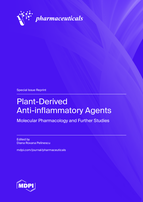Plant-Derived Anti-inflammatory Agents: Molecular Pharmacology and Further Studies
A special issue of Pharmaceuticals (ISSN 1424-8247). This special issue belongs to the section "Natural Products".
Deadline for manuscript submissions: closed (20 May 2023) | Viewed by 18395
Special Issue Editor
Interests: cell biology; microbial molecular biology; microbiota; virulence factors; antimicrobials
Special Issues, Collections and Topics in MDPI journals
Special Issue Information
Dear Colleagues,
Nature has represented and still is a great pool of biologically active compounds, and at the same time is a source of inspiration. In the first phase the researchers turned their attention to the new compounds isolated from plants and their characterization in terms of their beneficial effects on human health. Recently, however, there have been extensive studies on the synthesis of compounds analogous to plant-derived compounds in order to prevent or treat diseases such as diabetes, obesity, chronic liver diseases, respiratory diseases, cardiovascular diseases, cancer, and so on. One of the mechanisms involved in the beneficial effect on human health is represented by plant-derived compounds’ anti-inflammatory effect. Millions of people present inflammatory diseases, and international organizations including the World Health Organization (WHO) have recently considered this disorder to be a major global health concern. There are many studies regarding the anti-inflammatory activity of different plant-derived compounds (e.g., curcumin, coumarins, capsaicin, quercetin, resveratrol). Despite the large amount of data accumulated so far, it is necessary to continue studies on plant-derived anti-inflammatory agents in order to find more efficient treatments for inflammatory diseases. We would like to invite and encourage the publication of papers on this and related subjects relevant to the presented Special Issue topic.
Dr. Diana Roxana Pelinescu
Guest Editor
Manuscript Submission Information
Manuscripts should be submitted online at www.mdpi.com by registering and logging in to this website. Once you are registered, click here to go to the submission form. Manuscripts can be submitted until the deadline. All submissions that pass pre-check are peer-reviewed. Accepted papers will be published continuously in the journal (as soon as accepted) and will be listed together on the special issue website. Research articles, review articles as well as short communications are invited. For planned papers, a title and short abstract (about 100 words) can be sent to the Editorial Office for announcement on this website.
Submitted manuscripts should not have been published previously, nor be under consideration for publication elsewhere (except conference proceedings papers). All manuscripts are thoroughly refereed through a single-blind peer-review process. A guide for authors and other relevant information for submission of manuscripts is available on the Instructions for Authors page. Pharmaceuticals is an international peer-reviewed open access monthly journal published by MDPI.
Please visit the Instructions for Authors page before submitting a manuscript. The Article Processing Charge (APC) for publication in this open access journal is 2900 CHF (Swiss Francs). Submitted papers should be well formatted and use good English. Authors may use MDPI's English editing service prior to publication or during author revisions.
Keywords
- anti-inflammatory compounds
- plant-derived
- pharmacology
- mechanisms of action







